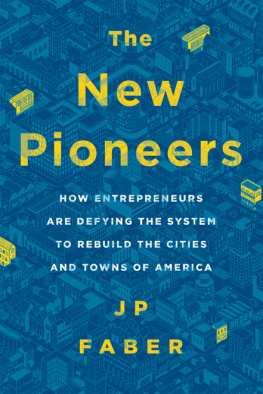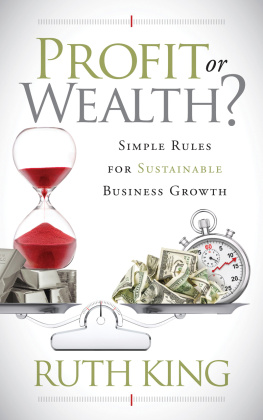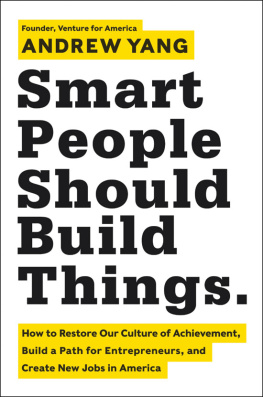Praise for The New Pioneers
I predicted years ago that the idiotic and unreformable over-burden of building and zoning codes would eventually have to be ignored by anyone seeking to rebuild this country at the small scale and the fine grain. That outcome has now been realized in Lean Urbanism, a set of ingenious work-arounds for those determined to rescue our dying towns and cities. This book is the first herald of that momentous revolution.
JAMES HOWARD KUNSTLER, author of
The Geography of Nowhere and The Long Emergency
This book is one of the few collections of real world case studies showing that if you reduce regulations and move toward a more libertarian model, huge creative energies will be released and wealth created. This book tells that story in a highly readable and concrete way that makes the abstract principles of a free society very real and immediate.
JENNIFER GROSSMAN, CEO of The Atlas Society
The
New
Pioneers

Copyright 2017 by J.P. Faber
All rights reserved. No part of this book may be used or reproduced in any manner whatsoever without written permission except in the case of brief quotations embodied in critical articles or reviews.

BenBella Books, Inc.
10440 N. Central Expressway, Suite 800
Dallas, TX 75231
www.benbellabooks.com
Send feedback to
First E-Book Edition: June 2017
Library of Congress Cataloging-in-Publication Data
Names: Faber, J. P. (James Paris), 1954- author.
Title: New pioneers : how entrepreneurs are defying the system to rebuild the cities and towns of America / J.P. Faber.
Description: Dallas, TX : BenBella Books, Inc., 2017.
Identifiers: LCCN 2016057462 (print) | LCCN 2017014638 (ebook) | ISBN 9781944648312 (electronic) | ISBN 9781944648305 (trade cloth)
Subjects: LCSH: Urban renewalUnited States. | Community developmentUnited States. | EntrepreneurshipUnited States.
Classification: LCC HT175 (ebook) | LCC HT175 .F324 2017 (print) | DDC 307.3/4160973dc23
LC record available at https://lccn.loc.gov/2016057462
Editing by Debbie Harmsen
Copyediting by Scott Calamar
Proofreading by Kim Broderick and Lisa Story
Indexing by Amy Murphy Indexing & Editorial
Cover design by Connie Gabbert
Jacket design by Sarah Avinger
Text design and composition by Silver Feather Design
Printed by Lake Book Manufacturing
Distributed by Perseus Distribution
www.perseusdistribution.com
To place orders through Perseus Distribution:
Tel: (800) 343-4499
Fax: (800) 351-5073
E-mail:
Special discounts for bulk sales (minimum of 25 copies) are available.
Please contact Aida Herrera at .
This book is dedicated to the love of my life,
Lesley Fonger Faber, who taught me that
there really is hope for the human race.
CONTENTS
BY ANDRS DUANY
There was a time in this country when young, energetic people could get things done, and that time was not long ago. When I began my career as an architect we could actually get things builtand fast. My colleagues and I, then in our mid-twenties, did not know how good we had it. We thought it was perfectly normal that people of our age, with some training, could get on with it.
That was forty years ago, when nothing could stop young, energetic people. My partner Elizabeth and I had been driven to the Sunbelt by the recession of 1974, and within four years we were building high rises in Miami. The local zoning code was less than half an inch thick and the planning department inhabited wooden WWII barracks, each office entered from a long porch. There were no hurdles to getting permits.
In the early 1980s, when we designed a whole new town called Seaside in the Florida Panhandleone of the places visited in this bookWalton County didnt even have a bureaucracy to submit the plan to. It was enough to notify the county of commencement of construction, and so long as we followed the codes, we could call in the bulldozers and start to build. As it happened, the developer, Robert Davis, had to help set up a county planning office so that he could get an approval stampto show the bankers who were anxious about giving him a loan. Robert was thirty-five years old.
In that same Walton County, the most recent of our town plans took a year of bureaucratic wrangling by an army of lawyers and consultants. It had become almost impossibleat least for young, inexperienced peopleto get anything done, even if they were energetic. That was only twenty years later.
Such a weight of regulation, back when Seaside started, would have crushed us. And in Miami today, the bureaucracy is housed in an enormous labyrinth of high-rise office space; the codebook they administer is ten times as thick. If I handed it to one of our young colleagues at the office today they would smirk with millennial sarcasm, Really?
I understand them perfectly. At their age I would not have picked up that bloated monster either.
But the young are not sitting still. One of my youngest colleagues, Mike Lydon, went off to start a movement called Tactical Urbanism. It was a method through which small, evident things could get done, bypassing the bureaucracies, the impediments, and the hurdlesfew of which existed in my time. Mike and other tactical urbanists like Tony Garcia are marvelous, sanctioned or unsanctioned, at getting stuff done.
And yet, as I compare them with us at their age, their projects are too small and too temporary for such bright young minds. We are no longer enabling the energy of youth. We have forgotten that WWII was won by twenty-year-olds.
The architects, builders, and urban planners of my generation lived through the gradual growth of red tape, and we absorbed it as a slow drip. We never leapt out of the pot as it warmed. Now, it seems, the new generation will not step into the scalding situation. They actually cant.
So a movement called Lean Urbanism has emerged. This is what J.P. Faber has latched on to: the folks who have figured outand can teach ushow it is possible to bypass the impediments.
The phenomenon of the young encountering the codified world (as New Pioneers) has an interesting parallel that we noticed in Miami (and across America): that construction crews consist largely of immigrants. Many of them are extraordinarily skilled, the kind of workers who would have built their own houses in their native countries; here they are just labor for subcontractors.
They are also more than that. In Miami and other US cities, they build and modify their own houses without permits. They cant navigate the permits, nor do they need to. Imagine if the thirty million penniless immigrants who in the nineteenth century pioneered the west had required permits! We would not have crossed the Appalachians.
Our new immigrants now operate in a gray market, hoping not to be noticed as they build for themselves and start informal businesses. And our youthwhat are they doing? An inordinate number now channel their energy into the arts and the Internet, among the few areas where you can do things without a permit. But a pioneering few are not asking for permission to build or make things. Like new immigrants to America, they are just doing it.
For me personally, the moment of insight was my fifth visit to Detroit. Within that oceanic ruin, Mark Nickita showed me an archipelago of success. Hundreds of young people were renovating buildings, starting businesses, and opening restaurantswithout engaging the bureaucracy. It seems that when Detroit went bankrupt it wasnt just the police the city couldnt pay; it couldnt pay the bureaucracy either. The young and the energetic emigrated from cities like Brooklyn, Chicago, and San Franciscoall places where getting anything done was difficult, if not impossible.









